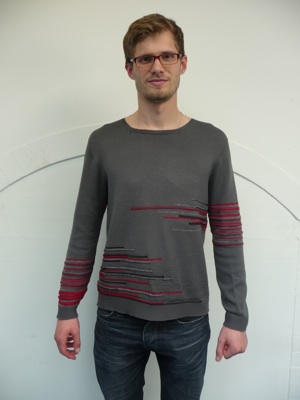A magazine where the digital world meets the real world.
On the web
- Home
- Browse by date
- Browse by topic
- Enter the maze
- Follow our blog
- Follow us on Twitter
- Resources for teachers
- Subscribe
In print
What is cs4fn?
- About us
- Contact us
- Partners
- Privacy and cookies
- Copyright and contributions
- Links to other fun sites
- Complete our questionnaire, give us feedback
Search:
The perfect fit

Having a one-of-a-kind garment tailored just for you is the height of fashion luxury. It fits you just right and you know that piece of clothing was made for you alone. It can feel like it’s a part of you. But let’s be honest: very few of us have custom-made clothes. Most of us make do with off-the-peg designs, made for the average dimensions of someone roughly the same size as us. But mass customisation could be coming your way, thanks to research at the London College of Fashion.
Sandy Black and her colleague Penelope Watkins wanted to help make clothes more special. Their research was part of a project called Considerate Design, which was all about designing clothes in a way that paid more attention to the people wearing them, and to the Earth. They thought that if they could find a way to make an item of clothing more special to the person wearing it, they would take better care of it and wear it for longer. Ultimately, we’d consume less – if clothing were less disposable we wouldn’t have to buy so much of it to replace the stuff we’d chucked away.
Scanning for lifeforms
How do you make it possible for more people to have custom clothes? With some impressive computer technology. Sandy and Penelope’s process begins by scanning the customer’s body with a 3D scanner. Then the body measurements and the customer’s style preferences are translated into a 2D computer design which can be used in an industrial knitting machine. (For more about how knitting patterns are like computer programs, see page xx.) The machine can produce a knitted jumper that comes out in one piece, practically ready to wear. If that jumper is yours, reflecting your own personal taste and fitting your own unique dimensions to a T, it’s likely to help reduce the impact that fashion has on the planet.

Future to the back?
The 3D body scanning technology used to take people’s measurements has other uses in fashion too. A different team on the Considerate Design project used the scans to design bags for people with back problems. After taking the scans and transferring them to real-life plaster moulds, designers shape the leather bags so that they conform exactly to the shape of the wearer’s back. That way the weight of the bag is transferred evenly to the hips and the wearer doesn’t suffer their usual pack pain.
If the researchers from the London College of Fashion have their way, in the future it will be much easier to get your clothes to fit you. Even better, though, our clothes will fit the Earth’s resources much more comfortably as well.


